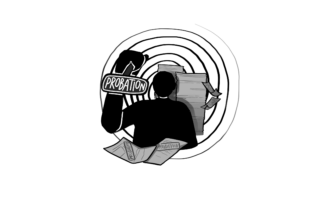Alcohol seems especially attractive to many high schoolers, being easier to obtain and seemingly safer than most drugs while still providing euphoric effects and, to some, a thrill of lawlessness. As such, many teenagers choose to try alcohol before they reach the legal drinking age of 21.
The drinking age was set to 21 after the passage of the National Minimum Drinking Age Act, a law that cuts highway funding by 10% for states with state drinking ages below 21 years. But the current drinking age has proven largely ineffective and possibly even damaging, leading to alcohol usage in secret by those under the age limit. To promote safe alcohol use, the Aragon Outlook supports reducing the minimum legal drinking age (MLDA) to 19.
The current drinking age doesn’t have much power over minors. The National Institute on Alcohol Abuse and Alcoholism reports that “Approximately 20 percent of 8th graders and almost 50 percent of 12th graders have consumed alcohol within the past 30 days.” Perhaps most surprisingly, the National Center on Addiction and Substance Abuse reports that underage drinking accounts for 17.5 percent of total consumer spending for alcohol in the United States. With low consequences and lots of paperwork, current drinking age laws are rarely enforced by police, with only about .2 percent underage drinkers being caught.
With drinking illegal for high schoolers and some college students, the student’s contact with alcohol is limited to unregulated and unsupervised environments such as house parties and kickbacks. Having one’s first exposure to alcohol in such a socially pressuring and alcoholically abundant environment can lead to faster and greater consumption of alcohol, higher risk of alcohol poisoning, and other unsafe activities. By drinking in secret and purchasing fake I.D.s, students are also forced to make moral compromises that ultimately erode their respect for the law.
Lowering the drinking age to 19 would mean that nearly all college students can drink in the open, allowing them to have the option of experiencing alcohol’s effects in a safer and more supervisable environment, as well as removing any thrill of lawlessness associated with drinking. Although the option of drinking in bars and restaurants does not completely circumvent the dangers of unregulated parties with plentiful alcohol, it provides an avenue for college students simply curious about alcohol to experience its effects in a comparatively safe environment.
So why 19? The majority of lower-drinking-age proponents advocate lowering the MLDA to 18, as that is when kids officially become adults. However, by setting the MLDA to 18, alcohol becomes easily accessible to many high school seniors, which will inevitably trickle down to lower grades. On the other hand, a MLDA at 19 ensures that high school seniors cannot legally purchase alcohol, precluding any possibility of large scale high school alcohol distribution. Setting the MLDA to 19 provides a balance between the desire to restrict high school alcohol consumption and bringing the legal age of alcohol consumption closer to high schoolers. By making the MLDA appear significantly closer, more high schoolers would hypothetically choose to wait to consume alcohol instead of risking the possible consequences of illegal drinking.
Of course, lowering the drinking age does not appeal to everyone. Mothers Against Drunk Driving, for example, is vehemently opposed to lowering the MLDA, pointing out that drunk driving accident rates have fallen since the passage of the federal drinking age law. However, the quoted statistic appears to suffer from confounding factors as drunk driving accident rates decreased among all age groups, not just 18-21 year olds, and have even decreased in other countries whose drinking ages have not been raised. The US has actually had a lower decrease of drunk driving accident rates than have many EU countries where the drinking age is below 21. Thus while fewer legal drinkers will obviously lead to fewer accidents involving inebriation, the mild benefits of a 21 MLDA are outweighed by the need to reduce illicit, and often binge, drinking.
Therefore, the Aragon Outlook supports reducing the Minimum Legal Drinking Age to 19. With such a change, college students will have a safer environment for drinking (as most will drink regardless of the current MLDA of 21), while high school students will have less of an incentive to drink illegally since legal age appears significantly closer.



